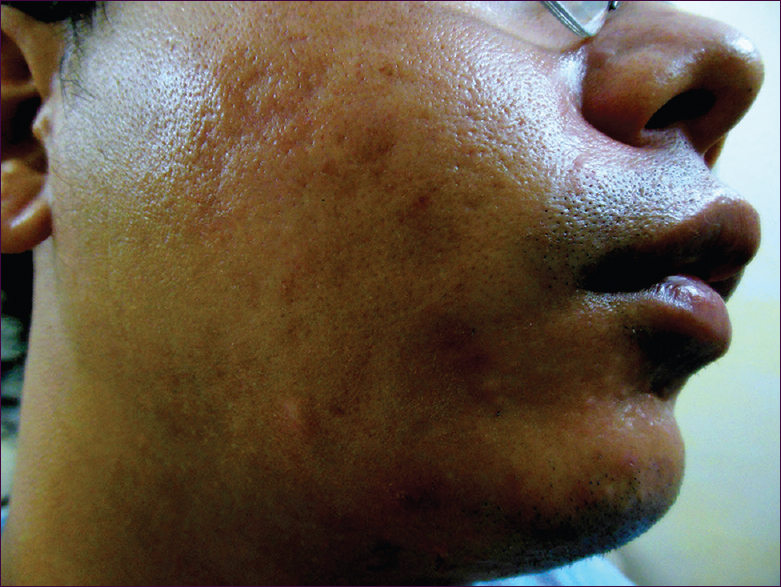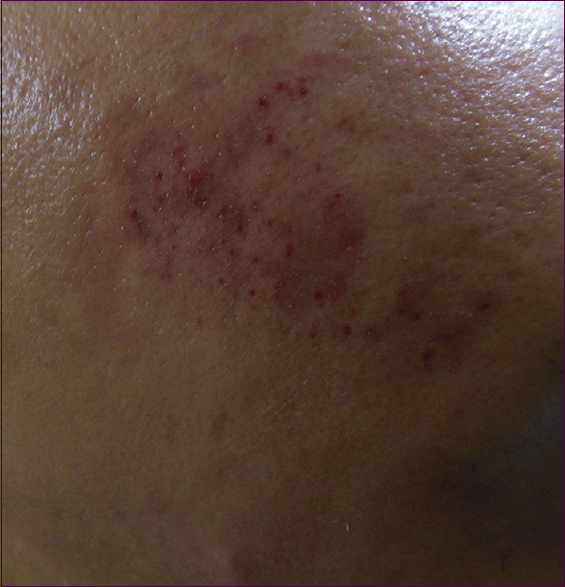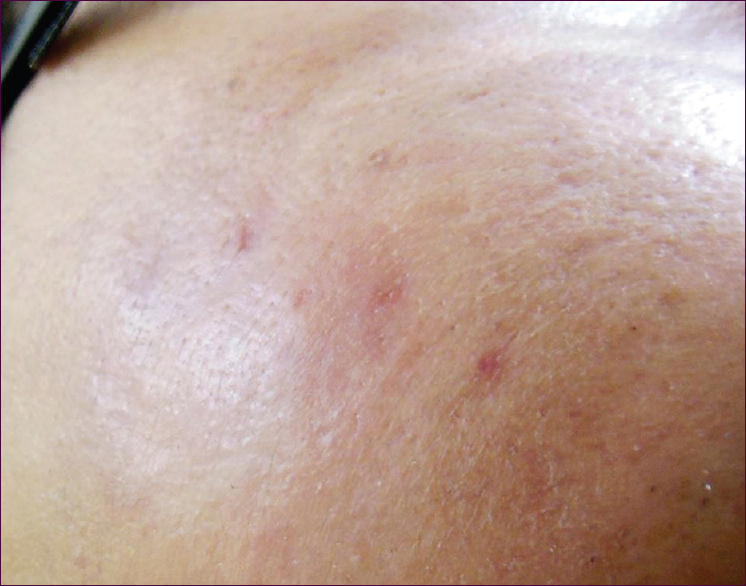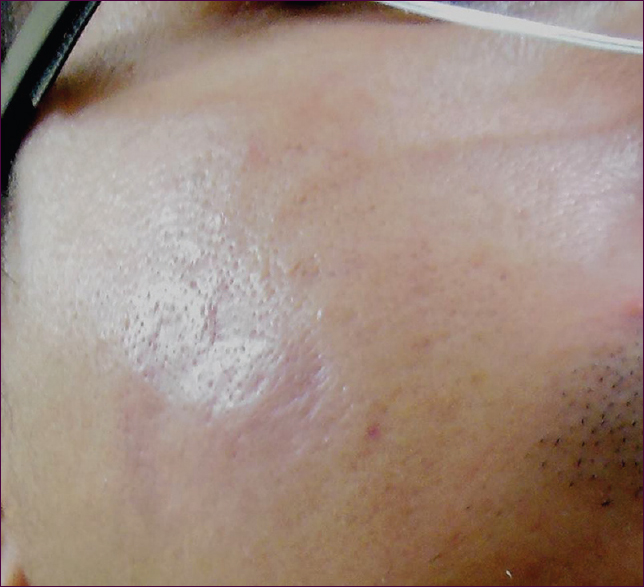Zonun’s regime (35% glycolic acid peel with microneedling followed by tretinoin 0.05% plus glycolic acid 12% application followed by salicylic acid 30% peeling) for treatment of acne scars: a pilot study
Zonunsanga
Department of Skin and VD, RNT Medical College, Udaipur, Rajasthan 313001, India
ABSTRACT
Introduction: Acne scars are the result of inflammation within the dermis brought on by acne. The scar is created by the wound trying to heal itself resulting in too much collagen in one spot. Current treatment available are not much satisfactory. Microneedling injure the dermis, thereby stimulating collagen formation. Glycolic acid acts as vehicle for delivery of drugs to dermis: in addition to that, it also has a role in collagen induction. Tretinoin helps in collagen formation. Salicylic acid remodel the superficial skin after the treatment. Material and Methods: A total of 4 patients in which 3 out of 4 patient, grade 3 acne scars and 1 out of 4 had grade 2 scar were treated with the regime. After taking consent 35% Glycolic acid peeling was done followed by microneedling. From the next day 12% Glycolic acid plus 0.05% Tretinoin is applied once a day for 2 months. After 2 months 30% Salicylic acid peeling is done. Photographs were taken before treatment, after 1 month and after 2 months of completion of the therapy and compared. Objective assessment was done according to Global Acne Scarring Classification. Result: subjectively 2 patients reported excellent response and 2 patients reported good response. Objectively, all patients showed good to excellent response. Conclusion: Zonun’s regime may be effective for treatment of acne scars.
Key words: Scars; Glycolic acid; Salicylic acid; Tretinoin; Microneedling
INTRODUCTION
Acne scars are the result of inflammation within the dermis secondary to acne. The scar is created by the wound trying to heal itself which results in excessive collagen in one spot. Post-acne facial scarring has a deep impact psychologically and the affected patient usually suffers from low self-esteem and many other psychological ill-effects because of this condition [1–3].
Facial scarring has always been a challenge to treat and there are different treatment options for the management of these scars. However, the majority of these treatment options have their limitations of either being marginally effective or else having considerable morbidity. Treatment options like laser resurfacing or dermabrasion that offer significant improvement in facial scars are invariably associated with considerable morbidity and downtime interference with the daily activities of the patient in the post-treatment period. On the other hand, treatments like microdermabrasion and non-ablative resurfacing with lasers that are associated with a minimal or no downtime, shows lesser efficacy than the traditional, ablative resurfacing techniques [1–4]. Monotherapy provides the benefits of exfoliation but may provide faster results and increased patient satisfaction when combined with superficial glycolic acid (alpha-hydroxy acid) peels because of the significant antiaging effects of glycolic acid peels [2–6].
There is still paucity in the current treatment available treatments for acne scars for which better and more satisfactory treatment is needed. At the same time, acne scar is not easy to treat and more aggressive treatment may be needed for better results.
MATERIALS AND METHODS
A Prospective pilot study was done on 4 patients, 1 with grade 2 acne scar and 3 with grade 3 acne scars; all were Fitzpatrick skin type 4; which was done at MBG Hospital Udaipur, Rajasthan. The patients with acne scar who have given consent for the treatment were included in the study. Patients with history of keloidal tendency, pregnant ladies, active acne and unco-operative patients were excluded from the study. Photographs were taken before treatment and then, 1 month and 2 months after completion of therapy.
On the first day, after draping the skin with spirit, followed by povidone iodine solution, 35% Glycolic acid peeling was done. Patients were asked to wash their face after 5 minutes. Then, Microneedling was done on the same day. Patients were asked to wash their face after 10 minutes. From 2nd day, 12% Glycolic acid plus 0.05% Tretinoin were applied daily at night for 2 months. The patients were given tab Vitamin C 500 mg daily. 35% Glycolic acid peeling plus Microneedling was repeated after 15 days. The patients were asked to use sunscreen on day time. Patients took oral antibiotics for 7 days after each microneedling to prevent infections.
After 2 months of completion of the therapy, the photographs were compared and assessed by two Dermatologists who were not involved in the study. Assessment was also done subjectively by asking the percentage of improvements from the patient. Objective assessment was also done according to Global Acne Scarring Classification.
RESULTS
After comparing serial photographs pretreatment, 1 month and 2 months after completion of the therapy, significant improvement was seen in all patients. Subjectively, 3/4 patients reported >70% improvements and ¼ reported 50-60% improvement. Objective assessment showed 2 out of 3 patients with grade 3 scars showed excellent response (shifting by 2 grades) and 1 out of 3 patients with grade 3 acne and 1 patient with grade 2 acne showed good response (shifting by 1 grade). Regarding the adverse effects, transient erythema was seen in all patients which was healed within 1-2 weeks.
DISCUSSION
Acne scars can cause emotional and psychosocial disturbance to the patient. Various modalities have been used for the treatment of acne scars like punch excision, subcision, peels, unfractionated and fractioned lasers and microneedling.
Glycolic acid is an alpha-hydroxy acid, which is soluble in alcohol. It is derived from fruit and milk sugars. Glycolic acid acts by thinning the stratum corneum, promoting epidermolysis and dispersing basal layer melanin. It increases dermal hyaluronic acid and collagen gene expression by increasing secretion of IL-6. Glycolic acid break the bonds and reach deeper into dermis. It acts as vehicle for delivery of the medication. It also helps in induction of collagen formation. By doing microneedling (a depth of 1.5 – 2 mm), skin develops multiple microbruises in the dermis that induces secretions of growth factors that finally results in collagen production. Histologically, thickening of skin and increase in new collagen and elastin fibers resulted. Tretinoin increases rate of shedding of skin and increasing growth of new skin, thereby causing faster scar reduction. Vitamin C also helps in collagen formation. Since Glycolic acid and tretinoin may cause photosensitivity, patients should use sunscreen on daytime. Saliylic acid is a beta hydroxy acid agent which removes intercellular lipids that are covalently linked to the cornified envelope surrounding cornified epithelioid cell. It helps in exfoliation of superficial layer of epidermis (keratolysis) as well as keratoplastic, and helps in reconstruction of skin surface [1–8].
A study conducted by Imran Majid on Microneedling therapy in atrophic facial scars on 36 patients showed that 34 patients achieved a reduction in the severity of their scarring by one or two grades. Subjectively, 29 patients reported the response as ‘excellent’ (7-10 on the 10-point scale), four patients reported the response as ‘good’ (score of 4-6) and only three patients reported the response as ‘poor’ (score of <4). The objective scoring showed 26 out of the total of 36 patients (72.2%) showed an excellent response to dermaroller treatment while six others achieved a good response (16.7%). Only four patients (11.1%) out of the total of 36 failed to show a significant response to treatment. A study conducted by the department of Dermatovenereology at the Sarajevo University Hospital centre on tretinoin for treatment of acne scars showed 79 % success rate [9].

Figure 1: Pretreatment

Figure 2: Immediate reaction
Figure 3 After 1 month
Figure 4: After 2 months
Sharad J also evaluated Combination of microneedling and glycolic acid peels for the treatment of acne scars in dark skin in a way that the subjects were divided into two groups. The first group comprised of 30 patients in whom only microneedling was performed once in 6 weeks for five sessions. In the second group of 30 patients, a combination of microneedling and 35% GA. Thirty patients in the age group of 20-40 peels was carried out. Patients from both groups were evaluated on the basis of Echelle d’Evaluation clinique des Cicatrices d’acné classification. He found out that, there was significant improvement in superficial and moderately deep scars (grade 1-3). There was also improvement in skin texture, reduction in postacne pigmentation in the second group [10].
Another study conducted by Qian H. et al on treatment of acne scarring with fractional CO2 laser have showed that at the 12 months follow-up time period, 12.9% of the patients showed excellent improvement in their acne scars, while 38.71% noted good to fair results. The clinical response at the 12-month follow-up visit tended to be better than at the 3-month follow-up visit, but was not statistically significant. Four patients experienced post-treatment and transient PIH but three patients were noted to have prolonged erythema. There was no evidence hypopigmentation or worsening of the scarring in any of the study patients [11].
In study conducted by Kaminaka C. et al on Clinical evaluation of glycolic acid chemical peeling in patients with acne vulgaris: a randomized, double-blind, placebo-controlled, split-face comparative study on 26 patients with moderate acne were treated with 40% GA (pH 2.0) on half of the face and placebo on the other half, performed five times at 2-week intervals showed statistically significant reductions in acne lesions at each time point from baseline values. There were statistically significant differences between the GA and placebo sides. The GA sides had better responses for noninflammatory lesions than for inflammatory lesions. In bioengineering measurements, sebum levels were statistically significantly reduced after the initiation of therapy on both sides at weeks 8 and 10, but there were no statistically significant differences between the two sides [12].
In this study, subjectively, the 2 patients reported excellent results (7-10 on 10 point scale), 2 patients reported good response (4-6). On objective assessment, 2 out of 3 patients (66.7%) with grade 3 acne scars were improved by two grades to grade 1 and were labelled as ‘excellent’ response. 1 (33.3%) out of 3 patients with grade 3 acne scars was improved by 1 grade to grade 2 and was labelled as ‘good’ response. 1 patient with grade 2 acne scar was improved to grade 1 and was labelled as ‘good response’. Overall, all the patients showed good to excellent response. This therapy not only reconstruct the acne scars, it also seems to cause glowing of skin which made the patient more satisfied with the treatment.
The lacunae of the study is less number of patients to make better and more precise efficacy and safety of the regime and effects of skin type and gender differences in response of the treatment. Besides, there was no single patient with grade 4 acne scar.
CONCLUSION
The combination therapy (zonun’s regime) may be effective treatment for treatment of acne scars. It also helps in glowing of skin in this study. Further study on more number of patients will be needed to get effects of skin type and gender differences, and also the influence of severity of acne scars, on response of the treatment. Further study on safety profile is also needed.
CONSENT
The examination of the patient was conducted according to the Declaration of Helsinki principles. Written informed consent was obtained from the patients for publication of this article and any accompanying images.
REFERENCES
1. Bhate K, Williams HC, What's new in acne? An analysis of systematic reviews published in 2011-2012Clin Exp Dermatol 2014; 39: 273-7.quiz 277-8
2. Briden E, Jacobsen E, Johnson C, Combining superficial glycolic acid (alpha-hydroxy acid) peels with microdermabrasion to maximize treatment results and patient satisfactionCutis 2007; 79: 1 Suppl Combining13-6.
3. Handog EB, Datuin MS, Singzon IA, Chemical peels for acne and acne scars in asians: evidence based reviewJ Cutan Aesthet Surg 2012; 5: 239-46.
4. Green BA, Yu RJ, Van Scott EJ, Clinical and cosmeceutical uses of hydroxyacidsClin Dermatol 2009; 27: 495-501.
5. Sharad J, Combination of microneedling and glycolic acid peels for the treatment of acne scars in dark skinJ Cosmet Dermatol 2011; 10: 317-23.
6. Kubiak M, Mucha P, Dębowska R, Rotsztejn H, Evaluation of 70% glycolic peels versus 15% trichloroacetic peels for the treatment of photodamaged facial skin in aging womenDermatol Surg 2014; 40: 883-91.
7. Knor T, Flattening of atrophic acne scars by using tretinoin by iontophoresisActa Dermatovenerol Croat 2004; 12: 84-91.
8. Hantash BM, Bedi VP, Kapadia B, Rahman Z, Jiang K, Tanner H, In vivo histological evaluation of a novel ablative fractional resurfacing deviceLasers Surg Med 2007; 39: 96-107.
9. Majid I, Microneedling therapy in atrophic facial scars: an objective assessmentJ Cutan Aesthet Surg 2009; 2: 26-30.
10. Sharad J, Combination of microneedling and glycolic acid peels for the treatment of acne scars in dark skinJ Cosmet Dermatol 2011; 10: 317-23.
11. Qian H, Lu Z, Ding H, Yan S, Xiang L, Gold MH, Treatment of acne scarring with fractional CO2 laserJ Cosmet Laser Ther 2012; 14: 162-5.
12. Kaminaka C, Uede M, Matsunaka H, Furukawa F, Yamomoto Y, Clinical evaluation of glycolic acid chemical peeling in patients with acne vulgaris: a randomized, double-blind, placebo-controlled, split-face comparative studyDermatol Surg 2014; 40: 314-22.
Notes
Source of Support: Nil
Conflict of Interest: None declared.


Comments are closed.